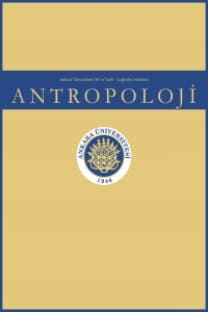Tefenni Kurtarma Kazısından Çıkan İskeletlerin Antropolojik Analizi ve Bir Kafatası Deformasyonu Örneği
Tefenni, Burdur Müzesi, kurtarma kazısı, nekropol, kültürel kafatası deformasyonu, paleopatoloji
The Anthropological Analysis of Skeletal Material from Tefenni Salvage Excavation and an Example of Artificial Cranial Deformation
Tefenni, Burdur Museum, salvage excavation, necropolis, artificial cranial deformation, paleopathology,
___
- Alpagut, B. (1986). Skeletons from Kurban Höyük-Urfa, Turkey. Anatolica, 13, 49-174.
- Brothwell, D. R. (1981). Digging up bones: The excavation, treatment and study of human skeletal remains. Oxford University Press.
- Buikstra, J. E., ve Ubelaker, D. H. (1994). Standarts for data collection from human skeletal remains. Arkansas Archeological Survey Research Series No. 44.
- Cleymans, S., ve Talloen, P. (2018). Protection in life and death: Pendant crosses from the cemetery of Apollo Klarios at Sagallasos, Turkey. European Journal of Archaeology, 21(2), 280-298. https://doi.org/10.1017/eaa.2017.55
- Cleymans, S., Talloen, P., Beaujean, B., Van de Vijver, K., ve Poblome, J. (2018). From burial to dump site: The history of the PQ4 compound at Sagalassos (southwest Anatolia). Anatolica, 44, 123-163. https://doi.org/10.2143/ANA.44.0.3285052
- Goodman, A. H., Martin, D. L., Armelagos, G. J., ve Clark, G. (1984). Indicators of stress from bone and teeth. M. N. Cohen ve G. J. Armelagos (Ed.) içinde, Paleopathology and the origins of agriculture (s. 13-49). Academic Press.
- Güleç, E. (1989). Paleoantropolojik verilere göre eski Anadolu bireylerinin boy açısından incelenmesi. Arkeometri Sonuçları Toplantısı, 5, 147-160. http://www.kulturvarliklari.gov.tr/sempozyum_pdf/arkeometri/05_arkeometri.pdf
- Koca Özer, B., Sağır, M., ve Özer, İ. (2011). Secular changes in the height of the inhabitants of Anatolia (Turkey) from the 10th millennium B.C. to the 20th century A.D. Economics and Human Biology, 9(2), 211-219. https://doi.org/10.1016/j.ehb.2010.12.003
- Meiklejohn, C., Agelarakis, A., Akkermans, P.A., Smith, P. E. L., ve Solecki, R. (1992). Artificial cranial deformation in the Proto-Neolithic and Neolithic Near East and its possible origin: Evidence from four sites. Paléorient, 18(2), 83-97. https://doi.org/10.3406/paleo.1992.4574
- Ortner, D. J. (2003). Identification of pathological conditions in human skeletal remains. Academic Press. https://doi.org/10.1016/B978-0-12-528628-2.X5037-6
- Ottoni, C., Rasteiro, R., Willet, R., Claeys, J., Talloen, P., Van de Vijver, K., Chikhi, L., Poblome, J., ve Decorte, R. (2016). Comparing maternal genetic variation across two millennia reveals the demographic history of an ancient human population in southwest Turkey. Royal Society Open Science, 3, 150250. https://doi.org/10.1098/rsos.150250
- Özbek, M. (1982). İnsan toplumlarında kafatası deformasyonları (Etnoantropolojik bir araştırma). Antropoloji, 11, 47-57. https://doi.org/10.1501/antro_0000000161
- Özsait, M. (1985). 1984 yılı Burdur-Isparta çevresi tarih öncesi sraştırmaları. Araştırma Sonuçları Toplantısı, 3, 389-408. http://www.kulturvarliklari.gov.tr/sempozyum_pdf/arastirmalar/03_arastirma.pdf
- Özsait, M. (2006). 2004 Yılı Burdur İli Yüzey Araştırmaları. Araştırma Sonuçları Toplantısı, 23(2), 259-262. http://www.kulturvarliklari.gov.tr/sempozyum_pdf/arastirmalar/23_arastirma_2.pdf
- Özsait, M. (2007). 2005 yılı Burdur İli yüzey araştırmaları. Araştırma Sonuçları Toplantısı, 24(2), 463-478. http://www.kulturvarliklari.gov.tr/sempozyum_pdf/arastirmalar/24_arastirma_2.pdf
- Özsait, M. (2008). 2006 Yılı Burdur ve Isparta İlleri Yüzey Araştırması. Araştırma Sonuçları Toplantısı, 25(2), 307-322. http://www.kulturvarliklari.gov.tr/sempozyum_pdf/arastirmalar/25_arastirma_2.pdf
- Özsait, M. (2009). 2007 Yılı Burdur, Isparta ve Antalya İlleri Yüzey Araştırması. Araştırma Sonuçları Toplantısı, 26(2), 357-372. http://www.kulturvarliklari.gov.tr/sempozyum_pdf/arastirmalar/26_arastirma_2.pdf
- Pearson, K. (1899). Mathematical contrubition on the theory of evolution: On the reconstruction of the stature of prehistoric races. Philosophical Transactions of The Royal Society, 192, 169-244. https://doi.org/10.1098/rsta.1899.0004
- Ricaut, F. X. ve Waelkens, M. (2008). Cranial discrete traits in a Byzantine population and eastern Mediterranean population movements. Human Biology, 80(5), 535-564. https://doi.org/10.3378/1534-6617-80.5.535
- Sağır, M. (2000). Uzun kemik radyografilerinden boy formülü hesaplaması. Yayımlanmamış Doktora Tezi. Ankara Üniversitesi Sosyal Bilimler Enstitüsü, Ankara.
- Sevim Erol, A., Yavuz, A. Y., ve Tarkan, D. (2015). Teke yöresinde yaşamış bir antik dönem toplumunun antropolojik analizi. Ş. Kazan Nas (Ed). içinde, I. Teke Yöresi Sempozyumu Bildiriler Kitabı, 1. Cilt (s. 615-626). Mehmet Akif Ersoy Üniversitesi.
- Soni, G., Dhall, U., ve Chhabra, S. (2010). Determination of sex from femur: Discriminant analysis. Journal of the Anatomical Society of India, 59(2), 216-221. https://doi.org/10.1016/S0003-2778(10)80029-2
- Şahin, S. (2016). Dilkaya toplumunun sağlık sorunları. Yayımlanmamış Doktora Tezi. Ankara Üniversitesi Sosyal Bilimler Enstitüsü, Ankara.
- The Workshop of European Anthropologists (1980). Recommendations for age and sex diagnosis of skeletons. Journal of Human Evolution, 9(7), 517-549. https://doi.org/10.1016/0047-2484(80)90061-5
- Trinkaus, E. (1982). Artificial cranial deformation in the Shanidar 1 and 5 Neandertals. Current Anthropology, 23(2), 198-199. https://doi.org/10.1086/202808
- Trotter, M., ve Glesser, G. (1952). Estimation of stature from long bones of American Whites and Negroes. American Journal Physical Anthropology, 10(4), 463-514. https://doi.org/10.1002/ajpa.1330100407
- Uysal, G. (1993). Oylum Höyük Erken Tunç Çağı çocuklarının paleodemografik açıdan analizi. Yayımlanmamış Yüksek Lisans Tezi. Hacettepe Üniversitesi Sosyal Bilimler Enstitüsü, Ankara.
- Yaşar, Z. F., Demirel, F. A., ve Çankaya, A. (2012) Burdur/Kızılin Mağarası iskeletlerinin antropolojik açıdan değerlendirilmesi. Ç. Ü. Sosyal Bilimler Enstitüsü Dergisi, 21(2), 129-142. http://static.dergipark.org.tr/article-download/imported/5000001592/5000002283.pdf?
- Yılmaz Usta, N. D. (2015). Antik insanın sosyokültürel yaşamını yansıtan bazı diş ve iskelet sistemi anomalileri. International Journal of Social Sciences and Education Research, 1(2), 547-559. https://doi.org/10.24289/ijsser.106451
- ISSN: 0378-2891
- Yayın Aralığı: Yılda 2 Sayı
- Başlangıç: 1963
- Yayıncı: Ankara Üniversitesi Basımevi
Tibia Kemiğine Ait Metrik Ölçümlerde Bilateral Asimetrinin Değerlendirilmesi
Ahmet İhsan AYTEK, Alper Yener YAVUZ, Orhan Gazi ÖZBEY, Evren ŞAHİN
Orta Anadolu’nun Doğusunda Bir Topluluk: Kayalıpınar İnsanları
“Kör Keçi”den “Körebe”ye: Oyun İçinde Oyun
Pınar KASAPOĞLU AKYOL, M. Muhtar KUTLU
Popülerleşen Deyişlerde Anlamı Yakalama ve Doğasına Dokunma Tartışmaları
Murat AKKUŞ, Ceren AKSOY SUGİYAMA
6-17 Yaş Arası Ankara Çocuk ve Adölesanlarında Büyüme Durumunun Değerlendirilmesi
Başak KOCA ÖZER, Ayşegül ÖZDEMİR, Sibel ÖNAL, Cansev MEŞE YAVUZ
Çevreden Kaynaklanan Göçün Boyutu: Gelişmiş ve Gelişmekte Olan Ülkeler Üzerine Bir Çalışma
Bitrokanterik Çap Mesafesi Genç Yetişkin Erkeklerin Flamingo Denge Testi Sonuçlarını Etkiler Mi?
Seda SERTEL MEYVACI, Handan ANKARALI
Eski Mezopotamya Mitolojisinde İnsanın Yaratılışı
Müslümantepe (Diyarbakır) Orta Çağ Yerleşiminde Yaşam Uzunluğu
